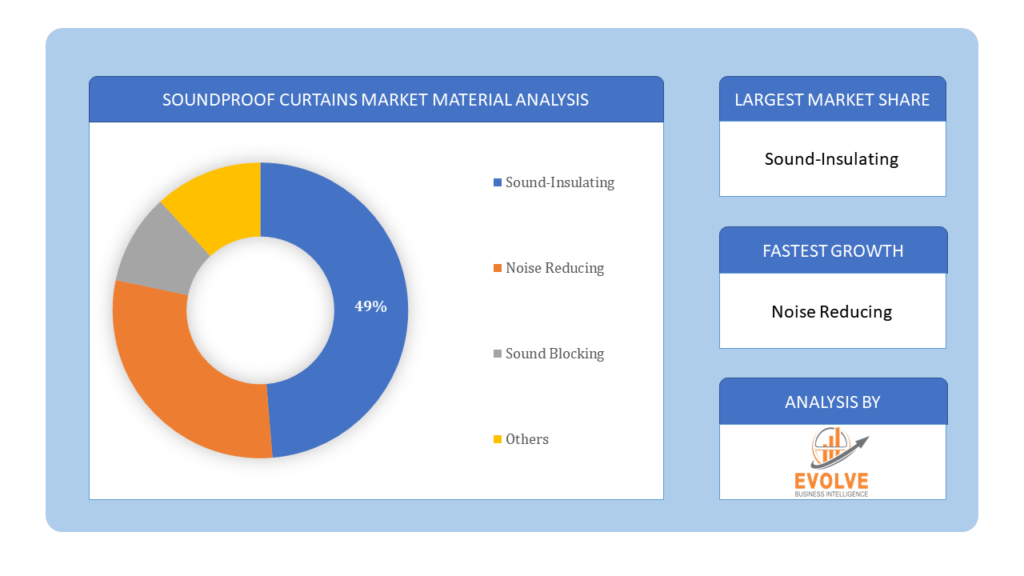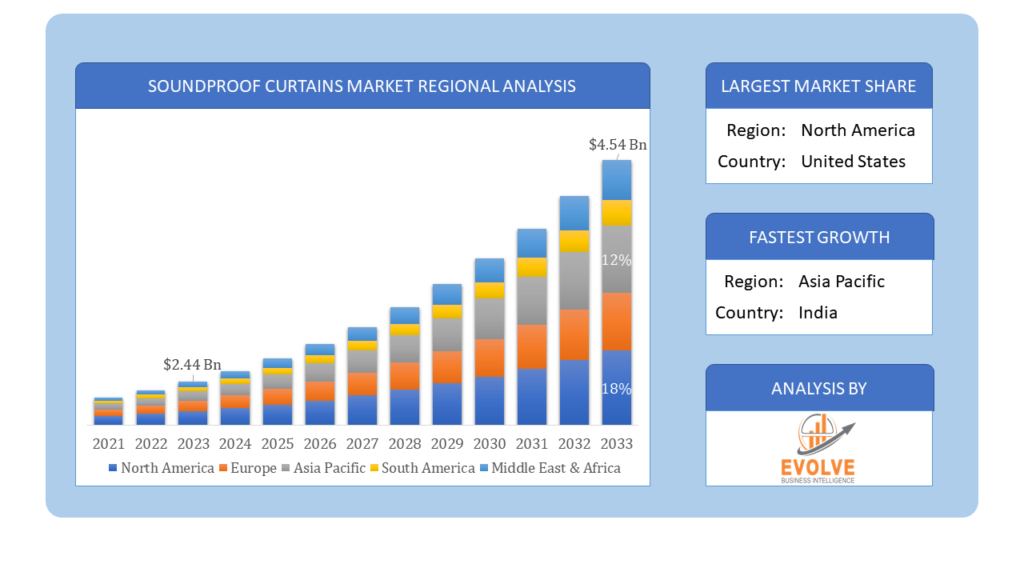Soundproof curtains Market Overview
The Soundproof curtains market Size is expected to reach USD 4.54 Billion by 2033. The Soundproof curtains market industry size accounted for USD 2.44 Billion in 2023 and is expected to expand at a compound annual growth rate (CAGR) of 4.57% from 2023 to 2033. The soundproof curtains market refers to the segment of the consumer goods industry that deals with the production, distribution, and sale of curtains designed specifically to reduce or block out noise. These curtains are often constructed with materials that have sound-absorbing properties, such as dense fabrics, multiple layers, or special acoustic materials.
The market for soundproof curtains has seen growth due to increasing awareness of the importance of noise reduction for comfort and productivity, as well as advancements in materials and technology for soundproofing purposes. Key factors such as urbanization, increasing noise pollution, and the rise of remote work have contributed to the demand for soundproofing solutions like these curtains.
Global Soundproof curtains market Synopsis
The COVID-19 pandemic had significant impacts on the soundproof curtains market. With many people spending more time at home due to lockdowns, remote work, and social distancing measures, there has been a surge in demand for home improvement products, including soundproof curtains. As individuals seek to create quieter and more comfortable home environments for work, relaxation, and leisure activities, the demand for soundproof curtains has increased. The pandemic has disrupted construction projects and renovations worldwide due to supply chain disruptions, labor shortages, and restrictions on movement and business operations. This has led to delays in the installation of soundproof curtains in commercial and residential buildings, impacting the market negatively. The economic downturn resulting from the pandemic has affected consumer spending patterns. While some consumers may invest in home improvement projects, others may prioritize essential expenses or delay discretionary purchases, including soundproof curtains.
Soundproof curtains Market Dynamics
The major factors that have impacted the growth of Soundproof curtains market are as follows:
Drivers:
Ø Advancements in Technology and Materials
Innovations in materials and manufacturing techniques have led to the development of more effective soundproofing solutions. Soundproof curtains made with advanced materials, such as dense fabrics, multiple layers, and acoustic foam, offer superior noise reduction capabilities, driving demand among consumers seeking high-performance products. The shift towards remote work and the rise of home offices have increased the demand for soundproofing solutions in residential settings. Soundproof curtains help create a conducive work environment by reducing distractions and improving concentration, leading to higher demand among remote workers and homeowners. Construction and renovation projects in residential and commercial sectors drive demand for soundproofing solutions, including curtains. Developers, homeowners, and businesses seeking to enhance the comfort and value of their properties often invest in soundproof curtains as part of their construction or renovation plans.
Restraint:
- Perception of High Cost
Soundproof curtains can be relatively expensive compared to conventional curtains due to their specialized materials and construction. The higher cost may deter budget-conscious consumers from purchasing soundproof curtains, limiting market penetration, especially in price-sensitive segments. Soundproof curtains often prioritize functionality over aesthetics, resulting in limited design options compared to traditional curtains. Consumers who prioritize interior design and décor may be reluctant to choose soundproof curtains that may not complement their existing aesthetic preferences, thus restraining market growth among this demographic.
Opportunity:
⮚ Rising Demand for Home Improvement Products
The increasing trend towards spending more time at home, driven by factors such as remote work and leisure activities, creates a significant opportunity for the soundproof curtains market. Consumers are increasingly investing in home improvement products to enhance comfort and productivity, leading to higher demand for soundproofing solutions like curtains. The growing prevalence of e-commerce and online retailing platforms provides an opportunity to reach a wider audience of consumers. Manufacturers and retailers can leverage digital channels to expand their market reach, improve accessibility, and offer convenience through online purchasing options, driving sales growth in the soundproof curtains market.
Soundproof curtains market Segment Overview
By Type
Based on Type, the market is segmented based on Sound-Reducing, Sound-Insulating and Sound-Blocking. The sound reducing segment led the largest market. Sound reducing curtain systems are products that custom engineered to the consumer’s application for acoustic performance and structural integrity. The soundproof curtains are a cost-effective solution that can be used to reduce unwanted noise. Most of the companies offer innovative products that are mostly used to control noise and vibration.
By Material
 Based on Material, the market has been divided into Rock Wool, Glass Wool, Plastic Foams and Natural Fibers. The glass wool segment dominant the market. Sand and recycled glass are both used to create the fibres that make up glass wool, an effective material for sound insulation. In order to make a sound-absorbing material that is commonly utilised in the construction sector, these fibres are joined together using a unique resin. Glass wool is a safe and environmentally beneficial material for use in soundproofing applications because it is non-combustible and does not release toxic gases.
Based on Material, the market has been divided into Rock Wool, Glass Wool, Plastic Foams and Natural Fibers. The glass wool segment dominant the market. Sand and recycled glass are both used to create the fibres that make up glass wool, an effective material for sound insulation. In order to make a sound-absorbing material that is commonly utilised in the construction sector, these fibres are joined together using a unique resin. Glass wool is a safe and environmentally beneficial material for use in soundproofing applications because it is non-combustible and does not release toxic gases.
By End User
Based on End User, the market has been divided into the Commercial, Residential and Industrial. The residential market accounted for the largest portion of revenue, driven by rising demand for soundproofing products in homes. The quickest revenue is anticipated in the commercial segment throughout the projection period because to the rising demand for soundproofing solutions in hotels, offices, and other commercial settings. The growing need for soundproofing solutions in factories, warehouses, and other industrial spaces is likely to propel the industrial segment’s steady growth in the upcoming years.
Global Soundproof curtains market Regional Analysis
Based on region, the global Soundproof curtains market has been divided into North America, Europe, Asia-Pacific, the Middle East & Africa, and Latin America. North America is projected to dominate the use of the Soundproof curtains market followed by the Asia-Pacific and Europe regions.
 North America Market
North America Market
North America holds a dominant position in the Soundproof curtains market. United States and Canada countries have high urbanization rates and significant levels of noise pollution, particularly in densely populated urban areas. The demand for soundproof curtains is driven by the need to mitigate noise from traffic, construction, and other urban activities. The prevalence of remote work and home offices further fuels demand for soundproofing solutions in residential settings.
Asia-Pacific Market
The Asia-Pacific region has indeed emerged as the fastest-growing market for the Soundproof curtains market industry. Urbanization and population growth are driving the expansion of construction activities in India’s major cities. With increasing awareness of the negative impacts of noise pollution on health and well-being, the demand for soundproof curtains is growing among urban residents.
Competitive Landscape
The global Soundproof curtains market is highly competitive, with numerous players offering a wide range of software solutions. The competitive landscape is characterized by the presence of established companies, as well as emerging startups and niche players. To increase their market position and attract a wide consumer base, the businesses are employing various strategies, such as product launches, and strategic alliances.
Prominent Players:
- Acoustical Surfaces Inc.
- HOFA
- Glt Products
- Flexshield
- Moondream
- Acoustic Curtains
- Kinetics Noise Control Inc.
- Sound Seal
- Steel Guard Safety Corp.
- Quiet Curtains
Scope of the Report
Global Soundproof curtains market, by Type
- Sound-Reducing
- Sound-Insulating
- Sound-Blocking
Global Soundproof curtains market, by Material
- Rock Wool
- Glass Wool
- Plastic Foams
- Natural Fibers
Global Soundproof curtains market, by End User
- Commercial
- Residential
- Industrial
Global Soundproof curtains market, by Region
- North America
- US
- Canada
- Mexico
- Europe
- UK
- Germany
- France
- Italy
- Spain
- Benelux
- Nordic
- Rest of Europe
- Asia Pacific
- China
- Japan
- South Korea
- Indonesia
- Austalia
- Malaysia
- India
- Rest of Asia Pacific
- South America
- Brazil
- Argentina
- Rest of SouthAmerica
- Middle East &Africa
- Saudi Arabia
- UAE
- Egypt
- SouthAfrica
- Rest of Middle East & Africa
| Parameters | Indicators |
|---|---|
| Market Size | 2033: $4.54 Billion |
| CAGR | 4.57% CAGR (2023-2033) |
| Base year | 2022 |
| Forecast Period | 2023-2033 |
| Historical Data | 2021 |
| Report Coverage | Revenue Forecast, Competitive Landscape, Growth Factors, and Trends |
| Key Segmentations | Type, Material, End User |
| Geographies Covered | North America, Europe, Asia-Pacific, Latin America, Middle East, Africa |
| Key Vendors | Acoustical Surfaces Inc., HOFA, Glt Products, Flexshield, Moondream, Acoustic Curtains, Kinetics Noise Control Inc., Sound Seal, Steel Guard Safety Corp. and Quiet Curtains. |
| Key Market Opportunities | • Rising Demand for Home Improvement Products • E-commerce and Online Retailing |
| Key Market Drivers | • Advancements in Technology and Materials • Remote Work and Home Offices |
REPORT CONTENT BRIEF:
- High-level analysis of the current and future Soundproof curtains market trends and opportunities
- Detailed analysis of current market drivers, restraining factors, and opportunities in the future
- Soundproof curtains market historical market size for the year 2021, and forecast from 2023 to 2033
- Soundproof curtains market share analysis at each product level
- Competitor analysis with detailed insight into its product segment, Government & Defense strength, and strategies adopted.
- Identifies key strategies adopted including product launches and developments, mergers and acquisitions, joint ventures, collaborations, and partnerships as well as funding taken and investment done, among others.
- To identify and understand the various factors involved in the global Soundproof curtains market affected by the pandemic
- To provide a detailed insight into the major companies operating in the market. The profiling will include the Government & Defense health of the company’s past 2-3 years with segmental and regional revenue breakup, product offering, recent developments, SWOT analysis, and key strategies.








